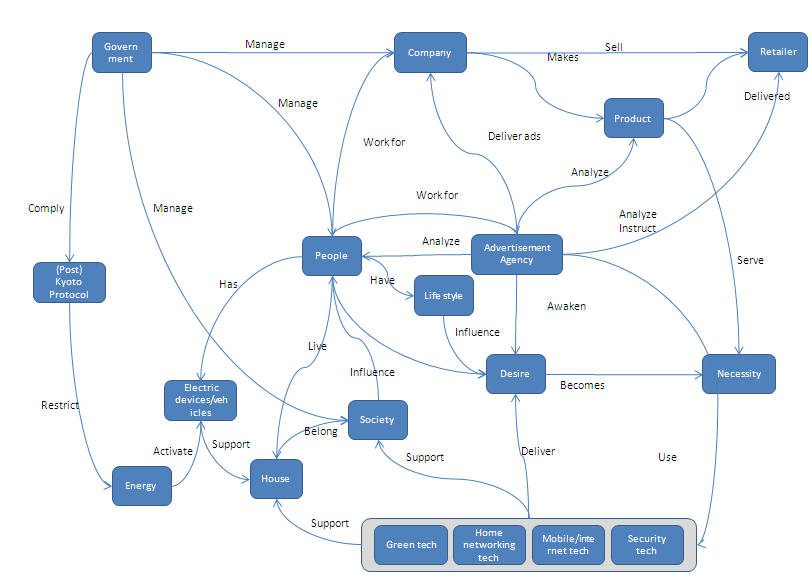Difference between revisions of "Future of Advertising in 2020"
Dcateriano (talk | contribs) |
|||
| Line 106: | Line 106: | ||
# [[what is current privacy issue?]]<br> | # [[what is current privacy issue?]]<br> | ||
# [[What is behavior advertising?]]<br> | # [[What is behavior advertising?]]<br> | ||
# [[What has been the evolution of facebook?]]<br> | |||
== Driving Forces == | == Driving Forces == | ||
Revision as of 11:52, 17 October 2009
Group
Daniela Cateriano
Kensuke Murai
Justin Block
Maggie Zhu
Vinod Nair
Introduction
Advertising in leaders' eyes
I define it as a conversation starter. Interruption
doesn’t cut it anymore. In the opt-in world, you either
get people talking, to each other or to themselves, or
nothing happens.”
—Marshall Ross, CCO, Cramer-Krasselt
The definition of advertising has not changed. It still
comes down to telling a story about a brand, it’s still
about creating ideas that people respond to. But the
consumer has changed. They have the power to
avoid marketing, and they know it. Brands have to
work a lot harder. More than ever, brands have to
offer something of value – something truly
entertaining, or surprising, thought-provoking or
useful. They have to be more generous.”
—Albert Kelly, ECD, Fallon
Advertising going forward is about turning big
ideas into personal experiences that change/
reinforce both perceptions and behavior.”
—Jan Leth, Vice Chairman/Global Digital Creative,
Ogilvy & Mather
“First there was a shift away from advertising towards talking about
‘content’ – brand content so good people want to engage with,
make their own, share with others, maybe even pay for. And at the
time, that felt like a new, fresh definition for what we do – but it’s still
fundamentally about making stuff. It’s describing the same old
production mentality in a new way, and expanding the palette a bit.
Now I prefer to define advertising more simply—just as ‘ideas.’ The
currency of our business is, and always has been, great ideas. The
strength of our thinking. But now the definition of those ideas is so
much broader – and holds more opportunity for agencies than ever
before. ‘Ideas’ goes beyond making creative deliverables A, B, C &
D to being go-to business counsel to clients at the highest levels. Getting knee-deep in every facet of their business. Bringing ideas
for new products and services, opening new selling channels,
industrial design and packaging; agencies creating their own
products/brands, or taking a financial stake in others.
The possibilities for this industry are limitless if we stop
focusing on making ads – and get ninja-like at bringing big, bold,
game-changing business ideas to our clients at such a relentless
pace, they might just cry uncle.”
—Jeff Graham, Account Director, Crispin Porter + Bogusky
“Make the truth appealing. You just have more ways
to do it now. I still think it’s about finding a big idea
based on a fundamental truth about a brand that’s
meaningful to the target audience, and expressing it
appropriately across multiple platforms.”
—Woody Kay, Managing Partner,
Chief Creative Officer, Arnold
“An encounter (that includes messages,
experiences, etc.) created by a brand in order
to generate awareness or build preference.”™
That’s the fundamental purpose. May include
experiences, a means of stimulating dialog and
social media, an invitation to create user generated
content. May appear on TV, the web, mobile or
embedded in a blood transfusion (coming soon). But the initiation still is created or stimulated or
inspired by the brand advertiser and exists to
generate awareness and preference. The purpose
and objective have not changed. Just the
technology, channels of distribution, options for
content and the role of the consumer.”
—Edward Boches, CCO, Mullen
“Advertising has not changed since the dawn
of time, only the media. I’m sure someone must
have written ‘Buy this fine reed basket.’ on a clay
tablet.”
—Mark Johnson, Chief Innovation Officer
Persuasion Arts & Sciences
“Story telling is king.
Problem is we sit around like a bunch of dorks talking
about which theatre this story is playing in. How many
seats. How big the screen is. Whether someone will
copy the links and send it to their friends.
The Internet is a venue. Not a fucking message.
If you can’t express yourself, all you’ve got is a
failure of imagination.”
—Bill Heater
Research questions
- Current State of Advertising
- Big players
- Demographics
- History of the industry
- Current trends
- What is the future of the print media?
- What are the innovations taking place for book substitutes?
- What is the projected trend for popularity of live events?
- How easily will be product information be accessible to consumers?
- Consumers: Will the definition change?
- What is internet privacy?
- what is current privacy issue?
- What is behavior advertising?
- What has been the evolution of facebook?
Driving Forces
Technological Driving Force
- Internet Technology
- Mobile Technology
- Security Technology
- Technology R&D
- Green Technology
- IPv6
- Smart Grid
- Digitization
Political Driving Force
Societal Driving Force
- Life Style
- Demographic Shift
- Guerrilla Marketing
- Online Social Networking
- Effects of increasingly segmented entertainment time
- Consumer forums
- Attitude and behavoir to Privacy
Economical Driving Force
Enviornmental Force
Scenarios
[[]]
Scenario 1: Hyper Personalized age
Scenario 2: Peer to peer review age
Scenario 3: Consumer Privacy takes over the Ad world
System Diagram
Interview
Interviewee: Professor Annet Aris, Adjunct Professor of Strategy, INSEAD
